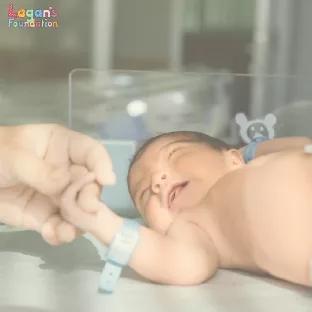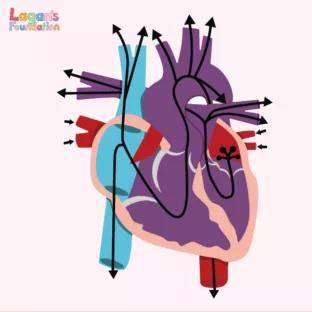A Guide to Atrioventricular Septal Defects (AVSD)
Complete & Partial AVSD
Atrioventricular Septal Defects are a combination of different heart problems that result in a defect in the centre of the heart. The condition occurs when there’s a hole between the heart’s chambers and ventricles, resulting in blood being poorly regulated by the heart.
What are Atrioventricular Septal Defects (AVSDs)?
Atrioventricular Septal Defects (AVSDs) are heart defects, in which there are holes between the chambers of the heart. The condition occurs during pregnancy, when the centre of the heart is not fully formed at birth.
There are two types of AVSD:
- Complete AVSD consists of a hole between the right and left side of the heart. The hole sits in the centre of the heart, and essentially creates two holes: one between the atriums and one between the ventricles.
- Partial AVSD is very similar to complete AVSD, but there are no holes between the ventricles. The hole sits between the two atriums.
Is AVSD life threatening?
If not treated or corrected appropriately, Atrioventricular Septal Defects can be seriously life threatening, especially for those who are born with complete AVSD.
If the AVSD is not treated, babies can suffer from congestive heart failure, in which the heart doesn’t pump blood as efficiently as it should. Despite its name, this doesn’t necessarily mean the heart has failed or is about to stop working. Instead, the heart muscles become less able to contract over time, which limits its ability to be filled with blood.
How often do Atrioventricular Septal Defects occur?
Overall, Atrioventricular Septal Defects are quite rare, and they account for 4% of heart defects in children. However, it is quite common for children who have Down Syndrome, occurring in about 25% of these children.
Congenital heart disease affects approximately 1 in 100 babies. All children who have an AVSD , both complete types and partial ones tend to require surgery to help repair them. Babies who have a complete AVSD will need surgery within the first 6 months of their lives, however a baby with a partial AVSD may not require surgery until they are a few years old.
How do Atrioventricular Septal Defects affect a child?
Children with Atrioventricular Septal Defects usually look perfectly healthy when they’re born. However, children with complete AVSD often gradually become breathless over the first month or so after birth. Children with partial AVSD will usually remain well.
Some babies with an AVSD may not have any other abnormalities, but many do. The most common issues are chromosomal abnormalities which are often associated with learning difficulties – Down Syndrome is the most common example.
With AVSD, blood flows where it normally shouldn’t go. The blood may also have a lower than normal level of oxygen and extra blood flows into the lungs. The extra blood that is being pumped to the lungs forces the heart and lungs to work harder, and can result in congestive heart failure.
How are Atrioventricular Septal Defects diagnosed?
Many cases of Atrioventricular Septal Defects can be diagnosed while the baby is still in the womb, but some are not detected until after birth.
During pregnancy
During pregnancy, Atrioventricular Septal Defects can be diagnosed with an ultrasound test. However, whether the heart defect can be seen depends on the type of AVSD. Alternatively, an echocardiogram can be used instead.
An echocardiogram is very similar to an ultrasound, but this scan will show the baby’s heart in much more detail than an ultrasound test. This can show problems with the structure of the heart and how well the heart is working.
After birth
After the baby is born, an Atrioventricular Septal Defect may be discovered during a physical examination. Using a stethoscope, a doctor will often hear a heart murmur if the baby has AVSD.
Babies who have complete AVSD usually do show signs of problems within the first few weeks after being born, including symptoms such as:
- Bluish tint to their skin
- Breathing problems
- Pounding heart
- Weak pulse
- Poor feeding and slow weight gain
- Tiring easily
- Swelling of the legs or belly
- Problems feeding which can lead to the baby having difficulty gaining weight
- Prone to chest infections
For babies who have partial AVSD, the holes between the chambers are not as large, meaning the signs and symptoms may not occur in the newborn or infancy periods.
Causes and risk factors of Atrioventricular Septal Defects
The causes of Atrioventricular Septal Defects, and other congenital heart defects, are mostly unknown. Some babies can have heart defects because of changes in their chromosomes, such as babies born with Down Syndrome.
AVSD is also thought to be caused by the combination of genes and other factors, such as things the mother comes into contact with in her environment, what food and drink she intakes and certain medications that she uses during pregnancy.
Things that can increase the risk of AVSD include:
- Genetics
- Rubella
- Diabetes
- Drug and alcohol use
- Smoking
- Certain medicines
How are Atrioventricular Septal Defects treated?
Most babies born with an Atrioventricular Septal Defect don’t need immediate treatment, but babies who become breathless can be given medicine to help improve their symptoms until surgery is carried out.
Surgery
Babies who have complete Atrioventricular Septal Defects will usually need major surgery to repair the defect when they are around 3-6 months old. Babies who have partial AVSD do not usually need surgery until they are a few years old.
The surgery is carried out under general anaesthetic, and works by stopping the function of the heart and lungs and taking them over with a “heart-lung machine” which makes sure blood is still pumped around the baby’s body. During the operation, the surgeon will close the hole(s) in the heart, and once the heart is repaired, it will be restarted.
After the operation, the baby will have a scar in the middle of their chest along the breast bone.
Further surgery
Although the surgery is called ‘repair’ or ‘corrective surgery’, it never makes the heart completely normal.
If your child has a replacement valve put in place, they will outgrow it at some point. This means it will have to be replaced with a larger one. The age in which surgery is done will vary from child to child.
What is the life expectancy of a child after AVSD repair?
Survival rate of Atrioventricular Septal Defects after repair surgery is over 85% for those 10 years after surgery, and 82% for those 20 years after surgery.
Life expectancy for those who have had surgery has increased significantly for those in the developed countries, with the current life expectancy being around 60 years old.


![Understanding Total Anomalous Pulmonary Venous Return [TAPVR]](/wp-content/uploads/2025/04/Understanding-Total-Anomalous-Pulmonary-Venous-Return-FI-312x312-c-default.jpg)


